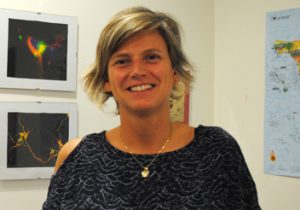Cristina Malagelada: “It is possible to know the time and severity in which a patient with Parkinson’s will have dyskinesia”
 The research group led by Dr Cristina Malagelada, from the Department of Biomedicine of the Faculty of Medicine and Health Sciences of the UB, has conducted a method to predict in which way dyskinesia will affect each patient with Parkinson’s.
The research group led by Dr Cristina Malagelada, from the Department of Biomedicine of the Faculty of Medicine and Health Sciences of the UB, has conducted a method to predict in which way dyskinesia will affect each patient with Parkinson’s.
The group recently received a VALUNI grant given by ACCIÓ, from the Generalitat de Catalunya, to bring the patent of this technology into the market. Dr Malagelada will also present this technology in the framework of the 16th Farma-Biotech Cooperation Meeting (FarmaIndustria), to be held in November in Madrid.
Which distinctive feature does your research on Parkinson’s disease have?
Since 1960, the main medication given to a person with Parkinson’s has been L-DOPA. It works well for some patients, but there are others who stop receiving its effects and it causes some shaking, called dyskinesia, which can be quite invalidating. No one knows for certain the severity of dyskinesia in each patient or when it will appear once the treatment starts.
Using a 64 gene signalling pathway, we analysed whether the patients with dyskinesia could be distinguished with some small genic marks. We carried several studies out with more than 1,400 patients during two years and we reached the conclusion that patients who got a stronger and earlier dyskinesia could be differentiated due some specific small marks. Now we want the study to turn into a diagnostic method; therefore, if someone is diagnosed with Parkinson, before starting with the drugs s/he would have a genetic analysis done (with blood or saliva) to get the DNA and see if the patient will suffer from dyskinesia before or after. At the moment there is no alternative to the L-DOPA therapy, that is why this test is so important.
What benefits would this analysis bring to the patients?
Dyskinesia causes unwanted and violent movements, different from the ones caused by Parkinson’s and which prevent people from having a normal life. The problem with all these movements is that the affected people spend a lot of energy and that causes important weight losses, a worse life quality… And once the dyskinesia appears, it is very difficult to go back.
With this analysis we can stratify patients so that those who have a higher risk of suffering from stronger and earlier dyskinesia can start the treatment with L-DOPA later or combine this drug with dopamine agonist drugs.
Where is the method now?
At the moment we want to find a company to license the method and validate the technique. The method worked out with the people who visit Hospital Clinic, but we have to see if it works with other people, since the marker inflow can vary depending on the genetic records of the patients. Our expectations on contacting companies are a bit uncertain, since with the business crisis many want to go for successful proposals. However we think it can be interesting to biotechnological companies and diagnostics centers which have drugs for dyskinesia, since it would be a way to stratify patients and delimit the given doses.
Do you think researchers will find a cure for Parkinson’s disease?
I think it will be easier to prevent than treating the disease. Once the disease is diagnosed, the patient lacks 70 % of dopaminergic neurons. Replacing those neurons is hard, because the disease is not about cells but also the environment. If we do not solve first the cause or different causes, it is hard to find a cure.
More information:
Fundació Bosch i Gimpera



No Comments